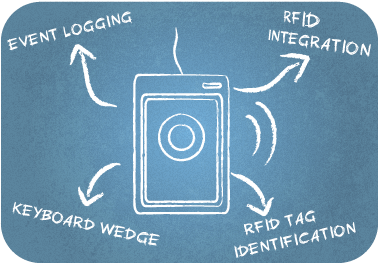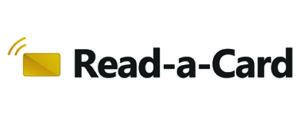Read-a-Card can be used in many ways
Read-a-Card for RFID card & tag identification
An ever increasing number of employers and educational establishments use electronic cards and tags for any number of purposes including photo-ID, cashless vending and buildings access. Usually these cards will use a contactless RFID technology such as MIFARE Classic, MIFARE Ultralight, MIFARE DESFire, iClass, HID Prox and FeliCa, to name but a few.
One of the biggest headaches facing Facilities, Security and IT Departments is knowing exactly what types of cards have been deployed, what information is stored inside them, and in what format. Understanding the technology used makes it much easier to re-order replacement cards, as well as considering whether the cards can be used for additional purposes, such as ‘follow me’ printing or time and attendance.
Similarly, system developers and access control installers often need to identify cards that have been previously supplied to their customers, so they can offer the best advice in terms of compatibility with different readers, migration to new technologies and integration with other systems and solutions.
Read-a-Card provides the ideal solution. When combined with appropriate readers, it can identify a wide range of different card brands and technologies from RFID manufacturers such as NXP, HID and Sony. It will also read standard ID data stored on a card, including site codes, and can be further customised to read specific data formats and sectors if needed. The data can be displayed on screen, or can be passed to other applications or logged to file for future reference.
Read-a-Card as a keyboard wedge
One of the challenges of introducing contactless cards and RFID tag technology to identify users or assets is how to make this work with existing software that might only be designed to accept data typed in by a user.
The same challenge applied to older systems that used barcodes for identification, and the solution that emerged was the ‘keyboard wedge’ – generally a barcode scanner fed the data into a PC through a special keyboard connector to make it appear as though it was being typed by a user.
As a result, many software applications expect data to be provided automatically in this manner, while in the case of RFID readers, most standard USB devices do not emulate a keyboard, but appear as a smart card reader device, which must be individually controlled through software.
Read-a-Card solves this problem by enabling standard desktop RFID readers to be utilised in keyboard wedge mode on any Windows-based PC. In this mode, Read-a-Card ‘types’ the card ID into the existing application’s window, as though it had been entered via the keyboard.
Additionally, Read-a-Card’s advanced keyboard format feature provides a simple means of software automation: you can tell Read-a-Card which keys it should press in order to drive your existing software through its menus and dialog fields and to insert the card ID (and possibly other information). Once set up to do this, Read-a-Card will do it automatically every time a card or tag is presented, while the configuration can be easily ‘locked’ to enable reliable operation in the field.
Read-a-Card for RFID event logging
Many organisations use RFID and contactless smart card technology to identify and track users and objects, and the technology is spreading through different markets and application areas, from buildings access to time and attendance monitoring, and from print management to production line control.
Modern systems tend to use high-frequency technologies such as MIFARE and iCode, based on standards such as ISO14443 and ISO15693. Although specialist reader hardware is available for use in high speed production environments, low-cost readers are also available for use on desktop PCs, typically connected via USB and appearing to Windows as a standard smart card reader.
Often there is a need to reliably capture and track events relating to cards or tags and feed this data into other systems for processing or analysis. This might involve logging of users entering a room, items being checked into stock, or assets being issued to users. Writing software to do this can be complex and time-consuming, due to the need to understand the low-level interfacing needed to read and write data via USB smart card readers.
Read-a-Card provides a quick and easy solution to this, by removing all development time and costs, and providing a convenient software platform for logging unique RFID information from cards and tags in a variety of file formats.
Read-a-Card supports most common contactless card technologies as well as readers from a wide range of manufacturers. It also supports multiple readers, enabling a single PC to log events at multiple locations, along with automatic time-stamping and reader identification.
Read-a-Card for RFID-enabling your application
The use of RFID technologies such as MIFARE, iClass and FeliCa for identifying and tracking users and objects is becoming more and more common, both in the workplace and in retail, transport and logistics environments. Many application developers are looking into how they can either use existing cards in a new way, or exploring how to issue cards and tags for new services and build a complete system around them.
If you are a developer, you may have been frustrated with the lack of information, open standards and available hardware and software components to enable the integration of RFID technology with your solution. Different readers, cards and protocols all mean that doing it on your own from scratch can be quite difficult and time consuming. And although choosing one particular technology or reader brand may short-cut some of this time, it is only at the expense of future flexibility and compatibility.
As well as the basic requirements of reading unique identifiers from different card types and with different USB smart card readers, you will probably also want a few ways to manipulate and handle this data, such as logging it to file, running a command or passing it to input fields in your software. You may also want to read specific data from secure sectors on a card, or link RFID data capture with a web-based server application running in a browser window.
Read-a-Card provides a solution to these requirements by enabling reader-independent RFID card reading functionality that can be easily integrated into software applications without any knowledge of the underlying technology or the low-level hardware interfacing techniques in Windows.
Integrating contactless smart cards and RFID reading capabilities is as simple as installing the Read-a-Card software to run in the background, and plugging in a supported reader. You can then use convenient, high-level APIs to capture the data you need and feed it to your software, irrespective of whether it is running as a native Windows PC application or as a web-based solution.


